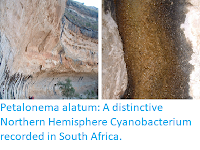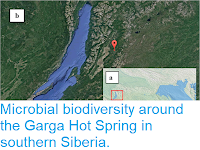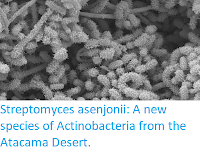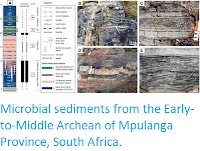Actinobacteria are Gram-positive, typically filamentous, aerobic Bacteria found in
soils and aquatic ecosystems, where they play a significant role in the
decomposition of Plant material and other organic matter, making them
highly important in the formation and maintenance of soils. Some species
of Actinobacteria are capable of 'fixing' nitrogen from the atmosphere
(i.e. taking atmospheric nitrogen and using it to form nitrogen
compounds that can be utilised by Plants). The genus Sinomonas are soil- or rock-dwelling Bacteria noted for a life-cycle in which they alternate between rod-shaped forms that form long filaments and coccoid (spherical) forms which form clusters. They are noted for the production of anti-fungal compounds, with some species being capable of fixing silver to form nanoparticles (which also have antimicrobial properties).
In a paper published in the journal Microorganisms on 8 June 2019, Yansong Fu, Rui Yan, Dongli Liu, Junwei Zhao, Jia Song, Xiangjing Wang, Lin Cui, and Ji Zhang of the Heilongjiang Provincial Key Laboratory of Agricultural Microbiology at the Northeast Agricultural University, and Wensheng Xiang, also of the Heilongjiang Provincial Key Laboratory of Agricultural Microbiology at the Northeast Agricultural University, and of the State Key Laboratory for Biology of Plant Diseases and Insect Pests at the Institute of Plant Protection of the Chinese Academy of Agricultural Sciences, describe a new species of Sinomonas from the Hadjer Lamis Region of Chad.
The new species is named Sinomonas gamaensis, meaning 'from Gama', in reference to the district of Gama; the new species was cultured from a soil sample collected from a cotton field in this area. The species was found to have formed rods after 12 hours of cultivation and cocci after 24 hours. The species was able to grow at temperatures of between 10°C and 45°C, with optimum growth at about 30°C, and at pH values of between 5 and 10, with an optimum of about 8.
Transmission electron micrograph of negatively staining cells of Sinomonas gamaensis after incubation for 12 hours (C) and 24 hours (D). Fu et al. (2019).
Sinomonas gamaensis was found to produce antifungal compounds which inhibited the growth of Exserohilum turcicum, the cause of Northern Corn Leaf Blight, a serious agricultural pest in cold temperate and highland regions.
The antagonistic activity of Sinomonas gamaensis (labelled as NEAU-HV1) against Exserohilum turcicum (a) and the antifungal activity of the supernatant and cell pellet of Sinomonas gamaensis against Exserohilum turcicum (b) Fu et al. (2019).
See also...
Follow Sciency Thoughts on Facebook.









